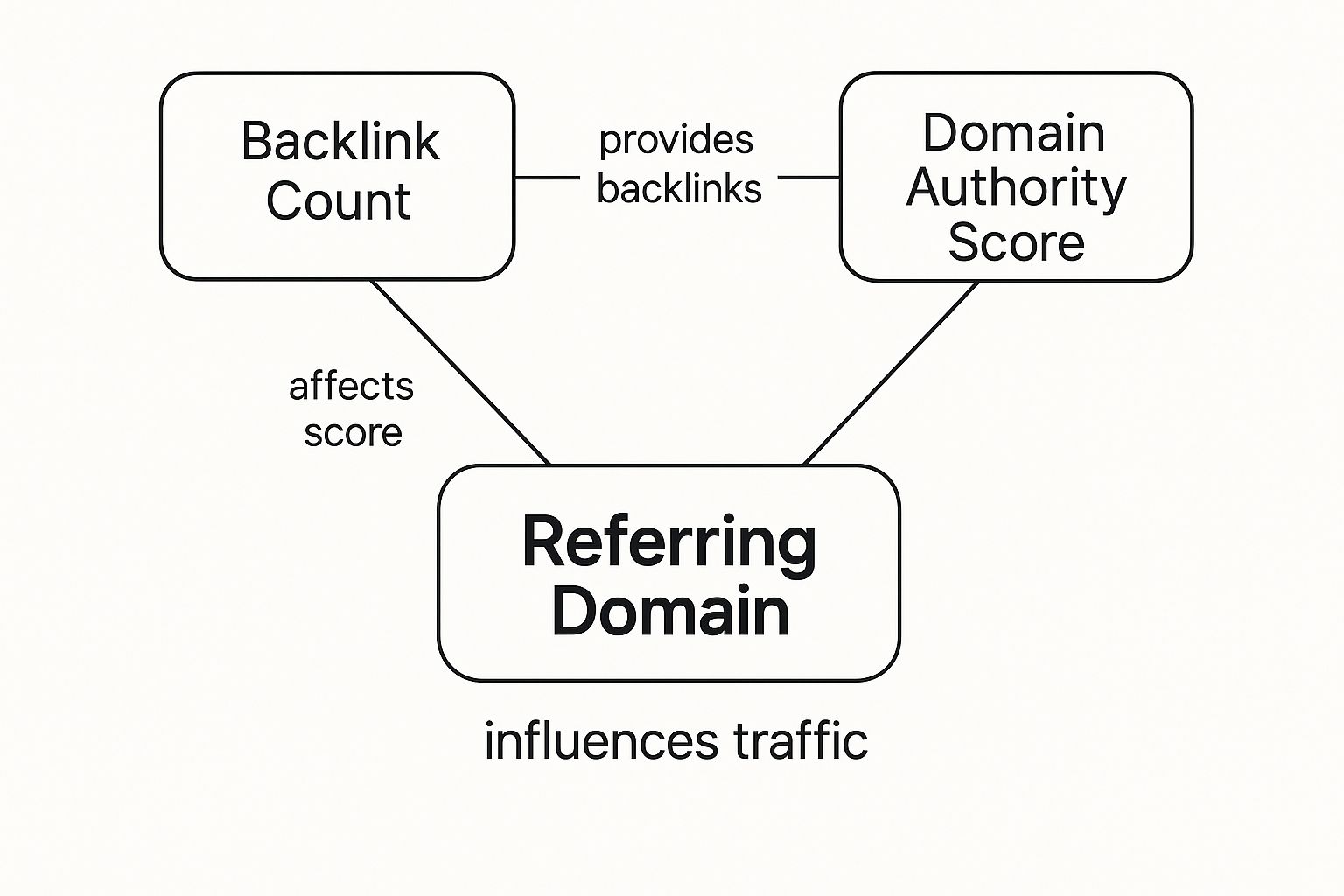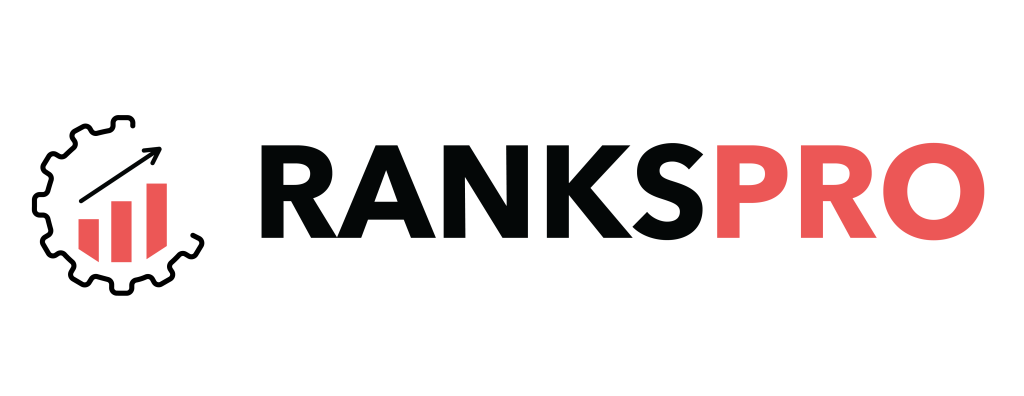Let's cut right to it. In the simplest terms, a referring domain is any website out there on the internet that links back to your website.
Think of it as a vote of confidence. When another site links to you, they're essentially pointing their audience in your direction. Each unique website that does this counts as one referring domain.
What Exactly Is a Referring Domain?
Imagine the internet is a massive, bustling city, and every website is a different shop. A backlink is like a customer leaving your shop and telling a friend, "Hey, you should check that place out!"
A referring domain is the shop that customer came from. One popular shop (a single referring domain) might send you dozens of customers (multiple backlinks). But what really builds your reputation across the city is getting recommendations from many different shops.
This distinction is absolutely crucial for SEO. Search engines like Google see links from a wide variety of unique domains as a much stronger signal of credibility than a bunch of links from the same old site. Why? Because it suggests your content has broad appeal and authority. Getting ten links from one blog is good, but getting one link each from ten different, relevant blogs is exponentially better for your rankings.
The Impact on Your Website's Authority
The number and quality of your referring domains have a direct, powerful influence on your site's SEO performance. The catch? Securing these "votes" is one of the toughest parts of the job.
An analysis of over one billion web pages found that a shocking 66.31% of them have zero backlinks from any referring domains. That's right—two-thirds of all pages on the internet are getting no external link endorsements at all, which severely limits their ability to rank for anything meaningful. You can dig into more link building statistics to see just how competitive it is.
This visual helps tie it all together, showing how referring domains are the foundation for backlinks, authority, and traffic.

As you can see, growing your count of high-quality referring domains is the first step toward boosting all the other metrics that matter. This is where a tool like RanksPro.io becomes invaluable. For example, using the Referring Domains report in RanksPro.io, you can monitor exactly which websites are endorsing you and measure how their authority contributes to your own. That data is your roadmap to building a trustworthy online presence that leaves the competition behind.
Referring Domain vs Backlink vs Referral Traffic
These terms often get jumbled, but they represent distinct concepts. Let's clear up the confusion with a quick comparison.
| Term | What It Is | Analogy |
|---|---|---|
| Referring Domain | The unique website that links to you. | The friend who recommends your business. |
| Backlink | The specific link on that website pointing to your page. | The specific recommendation itself. |
| Referral Traffic | The actual visitors who click that link to land on your site. | The people who show up at your business because of that friend's recommendation. |
Understanding this trio is fundamental. You want more referring domains to create more backlinks, which in turn drives more referral traffic. It's all connected, but it starts with earning those initial domain-level endorsements.
How Referring Domains Build SEO Authority

So, we know what a referring domain is, but why should you really care about them? Their true value is in how they build up your website’s authority in the eyes of search engines.
Think of it like getting a professional recommendation. A single, powerful endorsement from a highly respected expert in your field means a whole lot more than a dozen casual mentions from people nobody knows.
Search engines like Google see things in a very similar way. Each link from a new, high-quality referring domain is treated like a strong vote of confidence for your website. It's a signal that your content is credible, relevant, and worth paying attention to. This is the bedrock of earning trust and climbing the search rankings.
The Foundation of Trust and Relevance
Every time a reputable site links to you, it tells search engines your content has real value. That’s why referring domains are considered one of the most important key search engine ranking factors. A healthy, diverse profile of authoritative domains signals that you're a go-to resource in your niche.
This is where the old saying "quality over quantity" is more than just a cliché—it’s a rule. Seriously. One link from a major industry publication is infinitely more powerful than 100 links from spammy, irrelevant websites.
A strong referring domain profile is your digital reputation. It’s not just about how many sites link to you; it’s about who is linking to you and what their endorsement says about your brand.
For instance, getting a backlink from a globally trusted source like forbes.com or an official institution like harvard.edu sends a massive authority signal to Google. These types of domains are pillars of the internet's referral ecosystem. It's also worth noting that the web is always growing, with new generic top-level domains (ngTLDs) increasing by 13.5% year-over-year, which constantly opens up new avenues for earning great links.
From Authority to Traffic and Rankings
All this authority-building isn't just for show; it directly fuels your SEO success in very concrete ways. When you have a strong backlink profile driven by quality referring domains, you'll start to see tangible results.
Here’s what that looks like:
- Higher Search Rankings: Authoritative sites are rewarded with better visibility on the search engine results pages (SERPs). It’s that simple.
- Increased Referral Traffic: Links from popular, relevant sites don't just help with SEO—they send targeted visitors directly to your pages, often leading to valuable leads and sales.
- Enhanced Brand Credibility: Being cited by trusted sources positions your brand as a leader, building trust with both search engines and your audience.
Of course, you can't improve what you don't measure. For a practical example, by using RanksPro.io, you can track your referring domain count over a 6-month period and see a direct correlation with your keyword rankings. A user might notice that after gaining 20 new referring domains from relevant industry blogs, their primary keyword moved from page 2 to the top 5 results. This kind of insight lets you focus your energy on earning links that actually make a difference and build lasting SEO momentum.
How to Analyze Your Referring Domains with RanksPro.io
Alright, so you get the theory behind referring domains. But let's be honest, theory doesn't move the needle—action does. This is where we stop talking concepts and start getting our hands dirty to drive real SEO results. With a solid tool like RanksPro.io, you can ditch the guesswork and start making smart, data-backed decisions about your backlink profile.
First things first, jump into your RanksPro.io dashboard and head over to the ‘Backlink Analysis’ section. You're looking for the ‘Referring Domains’ report. Think of this as your mission control for everything related to your link profile. It’s far more than just a list of websites; it’s a living, breathing overview of who is talking about you online and how much weight their voice carries.
Pinpointing Your Strongest Allies
Once you open the report, you'll see every single domain that's pointing at least one link to your site. It can look like a lot at first, but RanksPro.io cuts through the noise by organizing everything with a few key metrics. The one you’ll want to focus on immediately is the Domain Rating (DR) score next to each domain.
DR is a simple 0-100 scale that measures a domain's backlink authority. The higher the number, the more powerful and trustworthy that link is in Google's eyes. It's a stamp of approval. In fact, studies have found that pages sitting at #1 on Google have an average of over 200 referring domains. By sorting your list by DR, you can instantly see which heavy-hitters are giving your SEO the most significant lift.

This dashboard gives you a clear, actionable picture of your backlink profile's health, letting you quickly spot your top-tier partners and figure out how to replicate that success.
Tracking New and Lost Opportunities
Here’s something every seasoned SEO pro knows: your backlink profile is never static. It's constantly in flux. Links appear, links disappear, and it often happens without any warning. This is where RanksPro.io really shines, thanks to its ‘New’ and ‘Lost’ referring domains filters.
A lost backlink from a high-authority domain is a red flag you can't ignore. It's a direct hit to your SEO value and can genuinely hurt your rankings.
By making it a habit to check the ‘Lost’ report, you can catch when a valuable link vanishes. For example, if RanksPro.io alerts you that you lost a DR 75 link, you can immediately investigate. This gives you a chance to reach out to the site owner, figure out what happened, and maybe even get that link put back up. On the flip side, the ‘New’ report is all about positive momentum. It shows you who just linked to you, giving you a perfect excuse to say thanks and start building a relationship.
When you combine this kind of backlink intelligence with our tools for SEO rank tracking, you get a 360-degree view of how your link building is directly affecting your search engine visibility.
Separating High-Value Links from Harmful Ones
Let's be honest: not all recommendations are created equal. You wouldn't take financial advice from a random stranger on the street, so why would you treat every referring domain as a win for your SEO? Learning to spot the difference between a genuinely valuable endorsement and a toxic link is one of the most important skills you can develop to protect your search rankings.
Think of yourself as a reputation detective for your website. A great referring domain is like a glowing review from a well-respected leader in your field. It’s relevant, it’s credible, and it tells Google that your content is the real deal. A harmful domain, on the other hand, is like a fake review from a known spammer—it can tarnish your reputation and pull your rankings down.
Hallmarks of a High-Quality Domain
So, how do you tell the good from the bad? Thankfully, high-quality domains tend to share a few clear characteristics. You can easily spot these traits using a tool like RanksPro.io.
- Strong Topical Relevance: The linking site needs to be in your world. A link from a top marketing blog to your SaaS company is pure gold. A link from a random pet grooming site? Not so much.
- High Domain Rating (DR): This is a simple score, from 0-100, that estimates a site's authority. A link from a site with a DR of 70+ is a powerhouse compared to one from a site with a DR of 10.
- Natural Link Placement: The link should look like it belongs. It should be placed naturally within the flow of an article, not awkwardly stuffed into a footer or a long, generic list of paid links.
The real test is this: A quality referring domain is one that would send you relevant, engaged traffic even if search engines didn't exist. That's the kind of authenticity Google's algorithms are built to reward.
Red Flags of a Harmful Domain
Just as good links have their tells, harmful domains often wave giant red flags. These are the kinds of links that can get you penalized and erase all your hard work. Be on the lookout for sites with zero traffic, links from irrelevant "link farms," or domains that are obviously part of a paid link scheme.
The best way to find these risks is to run a full analysis with a proper tool. For a deeper dive into finding and evaluating every link pointing to your site, you can learn more about how to use a backlink checker to stay protected. For example, using RanksPro.io's backlink checker, you can sort your referring domains by DR (low to high) to quickly identify low-quality sites (e.g., DR 0-10) with spammy-looking domain names, helping you catch these toxic links before they do any real damage.
Proven Strategies to Earn More Referring Domains

Knowing where your links come from is one piece of the puzzle. The other, more active piece is actually building that profile. Earning high-quality referring domains isn't about luck; it's a deliberate process that starts with creating undeniable value for your audience.
The goal is simple: make your content so incredibly useful, insightful, or authoritative that other websites can't help but reference it. This means you have to move past basic blog posts and start creating what we call "link magnets"—substantial pieces of content that naturally attract links because they are the resource on a topic.
Create Link-Worthy Content Assets
The bedrock of any good link-building campaign is content that genuinely deserves a link. Instead of just writing what you think people want, focus on creating assets that are proven to attract attention and citations from other sites. After all, pages ranking #1 in Google have, on average, over 200 referring domains. That's a pretty clear signal.
Here are a few powerful ideas to get you started:
- Original Data and Research: Run your own surveys or analyze industry data to publish findings nobody else has. This immediately makes you the primary source, and anyone who wants to cite that data has to link back to you.
- Comprehensive "Ultimate" Guides: Aim to create the single best, most thorough resource on a specific topic. If your guide is the most detailed and easiest to understand, other sites will naturally point to it as the definitive reference.
- Free Tools and Templates: Build a simple calculator, a handy checklist, or a downloadable template that solves a real problem for your audience. People love to share practical tools that make their lives easier.
If you want to dig deeper into growing your link profile the right way, check out these strategies on how to build backlinks naturally.
Uncover Competitor Opportunities
One of the smartest ways to find link opportunities is to simply look at who’s already linking to your direct competitors. This gives you a ready-made list of websites that are not only interested in your niche but have also shown they're willing to link out to valuable content.
Just pop a competitor's domain into the analysis feature in RanksPro.io, and you'll get an instant report of their referring domains.

This report is essentially a roadmap. It shows you exactly where your competitors are getting their traction, letting you target the very same domains with your own, superior content.
A competitor’s backlink profile is more than just data; it's a blueprint for your own outreach strategy. Identify the high-authority sites sending them traffic and create content that earns you a spot right alongside them.
This approach works so well because you're not guessing. You already know these sites are open to content in your niche. For a practical example, if RanksPro.io shows your top competitor has 150 referring domains and you only have 50, you can filter their list to find all domains with a DR over 40 that you don't have a link from. This creates an instant, high-value outreach list. This kind of smart analysis is a key reason to use an SEO tool for small businesses that offers deep competitor insights.
Still Have Questions? Here Are Some Common Ones
As you start digging into your site's referring domains, a few questions almost always pop up. Let's tackle them head-on with some practical, no-nonsense answers.
How Many Referring Domains Is "Enough"?
I get this one a lot. The honest answer? There’s no magic number.
It’s not about hitting some arbitrary target. It's about building a stronger, more trusted backlink profile than the other sites vying for your spot in the search results. Think of it less as a race to a finish line and more about staying ahead of your closest competitors.
The real goal is to consistently build a more authoritative presence than the sites you compete against on the search results page.
A great starting point is to see what you're up against. You can use a tool like RanksPro.io to peek at your main competitors. For example, if your top three competitors have 250, 300, and 400 referring domains respectively, your initial goal should be to surpass 250 to become competitive. This gives you a realistic benchmark to work towards.
Can Referring Domains Actually Hurt My SEO?
You bet they can. Links from spammy, irrelevant, or penalized websites can do serious damage to your search rankings.
Think of it this way: Google sees those toxic links and assumes your site is untrustworthy by association. This can lead to ranking drops or even a manual penalty, which can be a real headache to fix. For example, statistics show that over 10% of backlinks can come from spammy or low-quality sources. That's why keeping a close eye on who is linking to you with a tool like RanksPro.io is so critical.
What's the Fastest Way to Get More Referring Domains?
Everyone wants a shortcut, but when it comes to link building, "fast" is often a red flag for "risky." Quick-win tactics usually involve black-hat strategies that will get you into hot water with Google sooner or later.
The best, most reliable path is to create genuinely useful content that people want to link to. When you combine great content with smart outreach to relevant websites in your field, you build authority that lasts. It's a slow burn, but it's the only way to do it right.
Ready to take control of your SEO and build a backlink profile that truly works for you? RanksPro.io provides all the tools you need to analyze your referring domains, keep tabs on your competition, and uncover high-value link opportunities. Start your free trial today and see what data-driven SEO can do for your business.
Article created using Outrank




